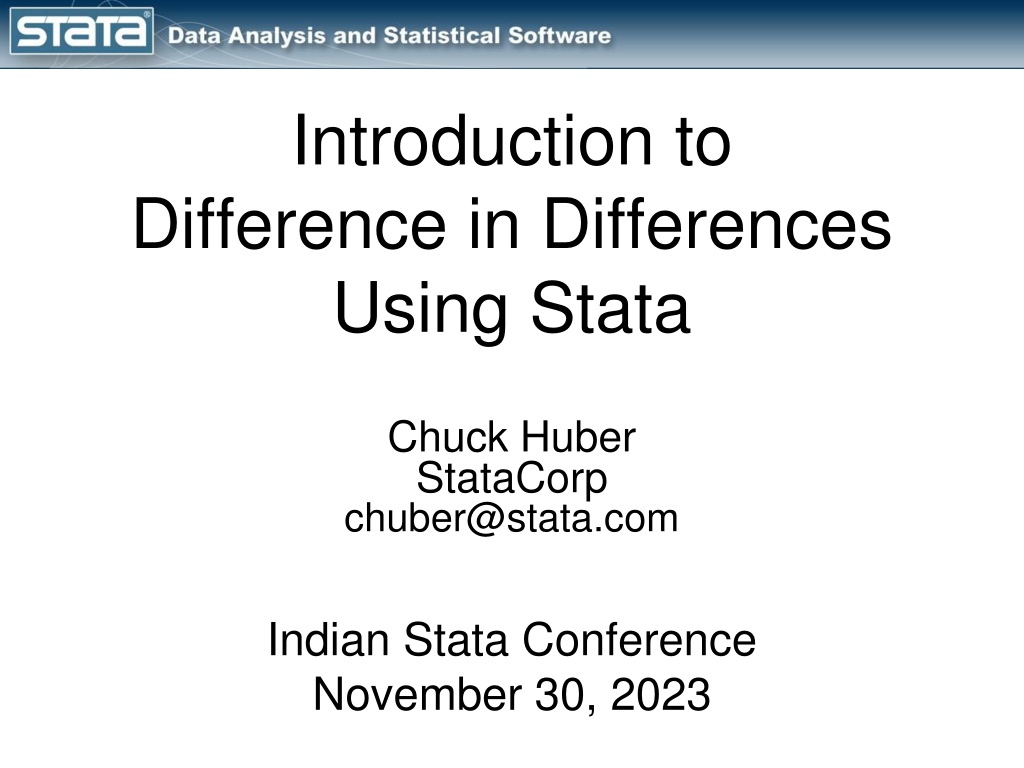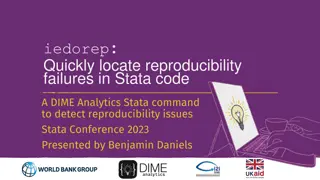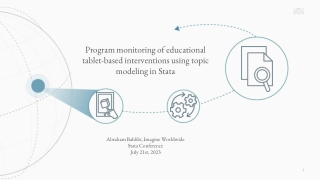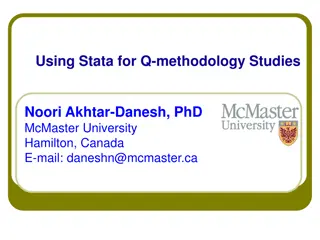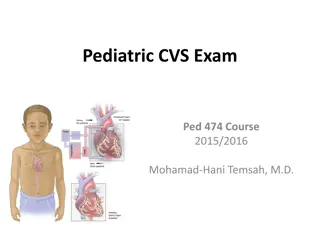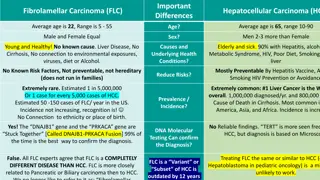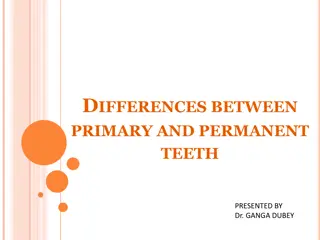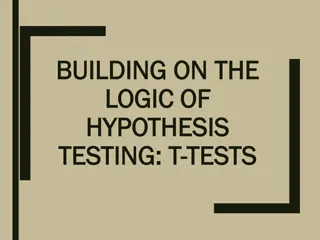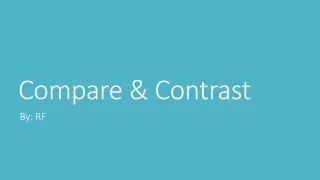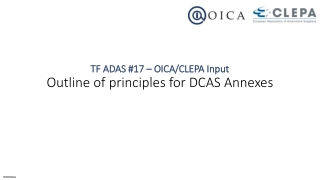Introduction to Difference in Differences Using Stata
Learn about Difference in Differences analysis using Stata with Chuck Huber at the Indian Stata Conference. The presentation covers the conceptual introduction, parallel trends assumption, and more using practical examples and panel data. Download slides and resources for further exploration.
Download Presentation
Please find below an Image/Link to download the presentation.
The content on the website is provided AS IS for your information and personal use only. It may not be sold, licensed, or shared on other websites without obtaining consent from the author. Download presentation by click this link. If you encounter any issues during the download, it is possible that the publisher has removed the file from their server.
Presentation Transcript
Introduction to Difference in Differences Using Stata Chuck Huber StataCorp chuber@stata.com Indian Stata Conference November 30, 2023
Download Website You can download all of the slides, datasets and do-files here: https://tinyurl.com/StataDID
Outline The Question An Intuitive Introduction Two Period, Two Groups Model Repeated Cross-Sectional Panel Data Longitudinal Panel Data Heterogeneous DiD Panel Data Heterogeneous DiD More Information
Outline The Question An Intuitive Introduction Two Period, Two Groups Model Repeated Cross-Sectional Panel Data Longitudinal Panel Data Heterogeneous DiD Panel Data Heterogeneous DiD More information
A Conceptual Introduction The Parallel Trends Assumption
Outline The Question An Intuitive Introduction Two Period, Two Groups Model Repeated Cross-Sectional Panel Data Longitudinal Panel Data Heterogeneous DiD Panel Data Heterogeneous DiD More information
The Example Dataset . use MLDA21, clear (Minimum Legal Drinking Age (MLDA) from Angrist and Pischke, 2014 (type 'notes')) . describe FIPS state year MLDA21_year MLDA21 mrate_agegrp beertax Variable Storage Display Value name type format label Variable label FIPS byte %10.0g State ID (Federal Information Processing Standard) state str15 %15s * State year int %9.0g * Year MLDA21_year int %10.0g Year in which MLDA21 law was enacted MLDA21 byte %15.0g treat83 Pre- or Post- MLDA21 Law mrate_agegrp double %9.2f * Mortality rate (deaths/100000) in the 18-20 age group beertax double %9.2f Beer tax
. list state mrate_agegrp MLDA21_year year MLDA21 /// > if inlist(FIPS, 17) /// > , sepby(state) nolabel noobs abbrev(18) state mrate_agegrp MLDA21_year year MLDA21 Illinois 80.52 1980 1970 0 Illinois 76.01 1980 1971 0 Illinois 66.14 1980 1972 0 Illinois 61.76 1980 1973 0 MLDA21 Law Not In Effect Illinois 39.25 1980 1974 0 Illinois 43.79 1980 1975 0 Illinois 55.84 1980 1976 0 Illinois 69.17 1980 1977 0 Illinois 56.85 1980 1978 0 Illinois 58.65 1980 1979 0 MLDA21 Law Enacted Illinois 58.39 1980 1980 1 Illinois 58.00 1980 1981 1 Illinois 47.69 1980 1982 1 Illinois 52.02 1980 1983 1 Illinois 57.47 1980 1984 1 Illinois 54.74 1980 1985 1 Illinois 61.50 1980 1986 1 Illinois 56.27 1980 1987 1 MLDA21 Law In Effect Illinois 53.08 1980 1988 1 Illinois 42.79 1980 1989 1 Illinois 43.12 1980 1990 1 Illinois 39.91 1980 1991 1 Illinois 39.46 1980 1992 1 Illinois 29.60 1980 1993 1 Illinois 53.91 1980 1994 1 Illinois 31.25 1980 1995 1 Illinois 41.03 1980 1996 1
. list state mrate_agegrp MLDA21_year year MLDA21 /// > if inlist(FIPS, 19) /// > , sepby(state) nolabel noobs abbrev(18) state mrate_agegrp MLDA21_year year MLDA21 Iowa 60.89 1986 1970 0 Iowa 52.81 1986 1971 0 Iowa 53.10 1986 1972 0 Iowa 67.56 1986 1973 0 Iowa 42.77 1986 1974 0 Iowa 46.04 1986 1975 0 Iowa 51.14 1986 1976 0 Iowa 57.04 1986 1977 0 MLDA21 Law Not In Effect Iowa 60.93 1986 1978 0 Iowa 64.25 1986 1979 0 Iowa 61.78 1986 1980 0 Iowa 63.47 1986 1981 0 Iowa 58.04 1986 1982 0 Iowa 48.86 1986 1983 0 Iowa 48.16 1986 1984 0 Iowa 54.54 1986 1985 0 MLDA21 Law Enacted Iowa 49.39 1986 1986 1 Iowa 37.57 1986 1987 1 Iowa 52.04 1986 1988 1 Iowa 33.37 1986 1989 1 Iowa 52.88 1986 1990 1 MLDA21 Law In Effect Iowa 41.15 1986 1991 1 Iowa 39.46 1986 1992 1 Iowa 40.30 1986 1993 1 Iowa 40.90 1986 1994 1 Iowa 45.98 1986 1995 1 Iowa 36.94 1986 1996 1
Setting Up The Data . keep if inrange(year, 1979, 1981) Keep the data for 1979, 1980, and 1981 (1,104 observations deleted) . . list state year if inlist(FIPS, 17,18,19) /// > , sepby(state) nolabel noobs abbrev(18) state year Illinois 1979 Illinois 1980 Illinois 1981 1979 is Pre 1980 is Treatment 1981 is Post Indiana 1979 Indiana 1980 Indiana 1981 Iowa 1979 Iowa 1980 Iowa 1981
Setting Up The Data . keep if inrange(year, 1979, 1981) (1,104 observations deleted) . . list state MLDA21_year year MLDA21 /// > if year!=1980 & inlist(FIPS, 17,18,19) /// > , sepby(state) nolabel noobs abbrev(18) state MLDA21_year year MLDA21 The law went into effect during the time interval Illinois 1980 1979 0 Illinois 1980 1981 1 The law was in effect during the entire interval The law was never in effect during the entire interval Indiana 1934 1979 1 Indiana 1934 1981 1 Iowa 1986 1979 0 Iowa 1986 1981 0
Setting Up The Data . // Create a variable for time . generate time = (year>1980) . . list state MLDA21_year year MLDA21 time /// > if year!=1980 & inlist(FIPS, 17,18,19) /// > , sepby(state) nolabel noobs abbrev(18) state MLDA21_year year MLDA21 time Illinois 1980 1979 0 0 Time equals 0 prior to the intervention in 1980 and time equals 1 after the intervention in 1980 Illinois 1980 1981 1 1 Indiana 1934 1979 1 0 Indiana 1934 1981 1 1 Iowa 1986 1979 0 0 Iowa 1986 1981 0 1
Setting Up The Data // Create a variable for treatment status gen treated = . replace treated = 0 if MLDA21_year >1980 replace treated = 0 if MLDA21_year <=1980 & year<1980 replace treated = 1 if MLDA21_year <=1980 . list state MLDA21_year year MLDA21 time treated /// > if year!=1980 & inlist(FIPS, 17,18,19) /// > , sepby(state) nolabel noobs abbrev(18) state MLDA21_year year MLDA21 time treated Treated equals 1 if the MLDA21 law was in effect in that state during 1980 or sooner. Treated equals 0 if the law went into effect after 1980. Illinois 1980 1979 0 0 1 Illinois 1980 1981 1 1 1 Indiana 1934 1979 1 0 1 Indiana 1934 1981 1 1 1 Iowa 1986 1979 0 0 0 Iowa 1986 1981 0 1 0
Setting Up The Data . // Create a variable for the interaction of time and treatment . gen TimeTreat = time*treated . . list state MLDA21_year year MLDA21 time treated TimeTreat /// > if year!=1980 & inlist(FIPS, 17,18,19) /// > , sepby(state) nolabel noobs abbrev(18) state MLDA21_year year MLDA21 time treated TimeTreat Illinois 1980 1979 0 0 1 0 Illinois 1980 1981 1 1 1 1 Indiana 1934 1979 1 0 1 0 Indiana 1934 1981 1 1 1 1 Iowa 1986 1979 0 0 0 0 Iowa 1986 1981 0 1 0 0 TimeTreat equals time x treated. It will be the interaction term when we use regress. It will be the treatment variable when we use didregress!!!!
DiD Using regress . regress mrate_agegrp time treated TimeTreat, vce(cluster FIPS) Linear regression Number of obs = 138 F(3, 45) = 5.76 Prob > F = 0.0020 R-squared = 0.0233 Root MSE = 22.879 (Std. err. adjusted for 46 clusters in FIPS) Robust mrate_agegrp Coefficient std. err. t P>|t| [95% conf. interval] time -3.92868 2.045822 -1.92 0.061 -8.049176 .1918168 treated 6.549406 6.480692 1.01 0.318 -6.503378 19.60219 TimeTreat -4.611695 3.32785 -1.39 0.173 -11.31433 2.090939 _cons 59.82451 3.878595 15.42 0.000 52.01262 67.6364 The Average Treatment Effect Among the Treated (ATET) is the coefficient for TimeTreat. The MLDA21 law caused a decrease of 4.6 people per 100,000 population in the 18-20 year old age group between 1979 and 1981.
DiD Using regress . regress mrate_agegrp i.time##i.treated, vce(cluster FIPS) Linear regression Number of obs = 138 F(3, 45) = 5.76 Prob > F = 0.0020 R-squared = 0.0233 Root MSE = 22.879 (Std. err. adjusted for 46 clusters in FIPS) Robust mrate_agegrp Coefficient std. err. t P>|t| [95% conf. interval] 1.time -3.92868 2.045822 -1.92 0.061 -8.049176 .1918168 1.treated 6.549406 6.480692 1.01 0.318 -6.503378 19.60219 time#treated 1 1 -4.611695 3.32785 -1.39 0.173 -11.31433 2.090939 _cons 59.82451 3.878595 15.42 0.000 52.01262 67.6364
DiD Using regress . regress mrate_agegrp i.year TimeTreat i.FIPS, vce(cluster FIPS) Linear regression Number of obs = 138 F(2, 45) = . Prob > F = . R-squared = 0.8714 Root MSE = 10.187 (Std. err. adjusted for 46 clusters in FIPS) Robust mrate_agegrp Coefficient std. err. t P>|t| [95% conf. interval] year 1980 -.5155614 2.882514 -0.18 0.859 -6.321242 5.29012 1981 -4.18646 3.313667 -1.26 0.213 -10.86053 2.487608 TimeTreat -4.611695 4.083392 -1.13 0.265 -12.83607 3.612679 FIPS 2 10.37779 2.88e-13 3.6e+13 0.000 10.37779 10.37779 4 3.268883 2.88e-13 1.1e+13 0.000 3.268883 3.268883 5 5.474611 1.361131 4.02 0.000 2.733153 8.216069 (FIPS output truncated)
DiD Using didregress didregress (outcomevaroutcomevarlist) /// (treatmentvar[, continuous]), /// group(groupvars) /// [time(timevar) options] didregress (mrate_agegrp) /// (TimeTreat), /// group(FIPS) /// time(year) TimeTreat = Time x Treat !!!!
DiD Using didregress . didregress (mrate_agegrp)(TimeTreat), group(FIPS) time(year) Number of groups and treatment time Time variable: year Control: TimeTreat = 0 Treatment: TimeTreat = 1 Control Treatment Group FIPS 33 13 Time Minimum 1979 1981 Maximum 1979 1981 Difference-in-differences regression Number of obs = 138 Data type: Repeated cross-sectional (Std. err. adjusted for 46 clusters in FIPS) Robust mrate_agegrp Coefficient std. err. t P>|t| [95% conf. interval] ATET TimeTreat (1 vs 0) -4.611695 4.083392 -1.13 0.265 -12.83607 3.612679 Note: ATET estimate adjusted for group effects and time effects.
Checking the Parallel Trends Assumption . estat ptrends Parallel-trends test (pretreatment time period) H0: Linear trends are parallel F(1, 45) = 0.02 Prob > F = 0.8871
Checking the Parallel Trends Assumption estat trendplots
didregress With Covariates . didregress (mrate_agegrp beertax)(TimeTreat), group(FIPS) time(year) Number of groups and treatment time Time variable: year Control: TimeTreat = 0 Treatment: TimeTreat = 1 Control Treatment Group FIPS 32 13 Time Minimum 1979 1981 Maximum 1979 1981 Difference-in-differences regression Number of obs = 135 Data type: Repeated cross-sectional (Std. err. adjusted for 45 clusters in FIPS) Robust mrate_agegrp Coefficient std. err. t P>|t| [95% conf. interval] ATET TimeTreat (1 vs 0) -5.140093 4.195906 -1.23 0.227 -13.59639 3.316199 Note: ATET estimate adjusted for covariates, group effects, and time effects.
Estimation of Standard Errors Must account for the serial correlation of the outcome. For a large number of groups By default, didregress uses cluster robust standard errors and uses critical values of a t distribution with G 1 degrees of freedom, where G is the number of groups. For more information: https://www.stata.com/manuals/tedidintro.pdf
Estimation of Standard Errors For a small number of groups wildbootstrap[(wildopts)] computes confidence intervals and p-values with the wild bootstrap. The wild bootstrap is constructed imposing the null hypothesis that the ATET is 0; that is, it is a restricted wild bootstrap. Confidence intervals are computed separately from the p-values. The bounds of the confidence interval are computed using a bisection optimization algorithm described in Methods and formulas in [TE] didregress. wildopts are errorweight(edtype), reps(#), rseed(#), and blocksize(#). errorweight(edtype) defines the error weight used to draw residuals from the wild bootstrap. edtype is one of rademacher (the default), mammen, webb, normal, or gamma. rademacher multiplies the residuals at each bootstrap replication with a randomly generated variable that takes the value of 1 with probability 0.5 and the value of -1 with probability 0.5. errorweight(rademacher) is the default. mammen multiplies the residuals at each bootstrap replication with a randomly generated variable that takes the value of 1 - phi with probability phi/sqrt{5} and phi otherwise, where phi = (1+sqrt{5})/2. webb multiplies the residuals at each bootstrap replication with a randomly generated variable that takes the values -sqrt{3/2}, -sqrt{2/2}, -sqrt{1/2}, sqrt{1/2}, sqrt{2/2}, and sqrt{3/2}, each with probability 1/6. normal multiplies the residuals at each bootstrap replication with a randomly generated normal distribution variable with the first four moments given by 0, 1, 0, and 3. gamma multiplies the residuals at each bootstrap replication with a randomly generated gamma distribution variable with shape parameter 4 and scale parameter 1/2. reps(#) performs # wild bootstrap replications. The default is reps(1000). rseed(#) sets the random-number seed to #. blocksize(#) specifies that the wild bootstrap be performed in blocks, with # replications per block. The wild bootstrap computation requires a matrix with dimensions (# groups) x (# replications). If this is too large, you can reduce the matrix to (# groups) x (# block size) and loop (# replications)/(# block size) times. When the same random seed is set, using a different block size does not change the numerical results; it only modifies the computation method. The block size must be less than or equal to the number of bootstrap replications.
Outline The Question An Intuitive Introduction Two Period, Two Groups Model Repeated Cross-Sectional Panel Data Longitudinal Panel Data Heterogeneous DiD Panel Data Heterogeneous DiD More information
DiD For Repeated Cross-Sectional Data use MLDA21, clear // Create a variable for time generate time = (year>1980) // Create a variable for treatment status gen treated = . replace treated = 0 if MLDA21_year >1980 replace treated = 0 if MLDA21_year <=1980 & year<1980 replace treated = 1 if MLDA21_year <=1980 // Create a variable for the interaction of time and treatment gen TimeTreat = time*treated
. list state MLDA21_year year MLDA21 time treated TimeTreat /// > if year!=1980 & inlist(FIPS, 17) /// > , sepby(state) nolabel noobs abbrev(18) state MLDA21_year year MLDA21 time treated TimeTreat Illinois 1980 1970 0 0 1 0 Illinois 1980 1971 0 0 1 0 Illinois 1980 1972 0 0 1 0 Illinois 1980 1973 0 0 1 0 Illinois 1980 1974 0 0 1 0 Illinois 1980 1975 0 0 1 0 Illinois 1980 1976 0 0 1 0 Illinois 1980 1977 0 0 1 0 Illinois 1980 1978 0 0 1 0 Illinois 1980 1979 0 0 1 0 Illinois 1980 1981 1 1 1 1 Illinois 1980 1982 1 1 1 1 Illinois 1980 1983 1 1 1 1 Illinois 1980 1984 1 1 1 1 Illinois 1980 1985 1 1 1 1 Illinois 1980 1986 1 1 1 1 Illinois 1980 1987 1 1 1 1 Illinois 1980 1988 1 1 1 1 Illinois 1980 1989 1 1 1 1 Illinois 1980 1990 1 1 1 1 Illinois 1980 1991 1 1 1 1 Illinois 1980 1992 1 1 1 1 Illinois 1980 1993 1 1 1 1 Illinois 1980 1994 1 1 1 1 Illinois 1980 1995 1 1 1 1 Illinois 1980 1996 1 1 1 1
DiD For Repeated Cross-Sectional Data . didregress (mrate_agegrp)(TimeTreat), group(FIPS) time(year) Number of groups and treatment time Time variable: year Control: TimeTreat = 0 Treatment: TimeTreat = 1 Control Treatment Group FIPS 33 13 Time Minimum 1970 1981 Maximum 1970 1981 Difference-in-differences regression Number of obs = 1,242 Data type: Repeated cross-sectional (Std. err. adjusted for 46 clusters in FIPS) Robust mrate_agegrp Coefficient std. err. t P>|t| [95% conf. interval] ATET TimeTreat (1 vs 0) -3.268054 4.212866 -0.78 0.442 -11.7532 5.217093 Note: ATET estimate adjusted for group effects and time effects.
DiD For Repeated Cross-Sectional Data . estat ptrends Parallel-trends test (pretreatment time period) H0: Linear trends are parallel F(1, 45) = 2.01 Prob > F = 0.1629
DiD For Repeated Cross-Sectional Data estat trendplots
Outline The Question An Intuitive Introduction Two Period, Two Groups Model Repeated Cross-Sectional Panel Data Longitudinal Panel Data Heterogeneous DiD Panel Data Heterogeneous DiD More information
